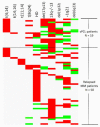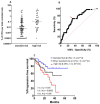The Cytogenetic Profile of Primary and Secondary Plasma Cell Leukemia: Etiopathogenetic Perspectives, Prognostic Impact and Clinical Relevance to Newly Diagnosed Multiple Myeloma with Differential Circulating Clonal Plasma Cells
- PMID: 35203419
- PMCID: PMC8869452
- DOI: 10.3390/biomedicines10020209
The Cytogenetic Profile of Primary and Secondary Plasma Cell Leukemia: Etiopathogenetic Perspectives, Prognostic Impact and Clinical Relevance to Newly Diagnosed Multiple Myeloma with Differential Circulating Clonal Plasma Cells
Abstract
Plasma cell leukemia (PCL) is a rare and aggressive plasma cell dyscrasia that may appear as de-novo leukemia (pPCL) or on the basis of a pre-existing multiple myeloma (MM), called secondary plasma cell leukemia (sPCL). In this prospective study, we have applied a broad panel of FISH probes in 965 newly diagnosed MM (NDMM) and 44 PCL cases of both types to reveal the particular cytogenetic differences among the three plasma cell dyscrasias. In order to evaluate the frequency and patterns of clonal evolution, the same FISH panel was applied both at diagnosis and at the time of first relapse for 81 relapsed MM patients and both at MM diagnosis and during sPCL transformation for the 19 sPCL cases described here. pPCL was characterized by frequent MYC translocations and t(11;14) with a 11q13 breakpoint centered on the MYEOV gene, not commonly seen in MM. sPCL had a higher number of FISH abnormalities and was strongly associated with the presence of del(17p13), either acquired at the initial MM stage or as a newly acquired lesion upon leukemogenesis in the context of the apparent clonal evolution observed in sPCL. In clinical terms, sPCL showed a shorter overall survival than pPCL with either standard or high-risk (t(4;14) and/or t(14;16) and/or del(17p13) and/or ≥3 concomitant aberrations) abnormalities (median 5 months vs. 21 and 11 months respectively, p < 0.001), suggesting a prognostic stratification based on cytogenetic background. These observations proved relevant in the NDMM setting, where higher levels of circulating plasma cells (CPCs) were strongly associated with high-risk cytogenetics (median frequency of CPCs: 0.11% of peripheral blood nucleated cells for high-risk vs. 0.007% for standard-risk NDMM, p < 0.0001). Most importantly, the combined evaluation of CPCs (higher or lower than a cut-off of 0.03%), together with patients' cytogenetic status, could be used for an improved prognostic stratification of NDMM patients.
Keywords: FISH; circulating plasma cells; clonal evolution; cytogenetics; multiple myeloma; primary plasma cell leukemia; secondary plasma cell leukemia.
Conflict of interest statement
The authors declare no conflict of interest.
Figures



Similar articles
-
Clinicopathological and laboratory parameters of plasma cell leukemia among Indian population.Am J Blood Res. 2022 Dec 15;12(6):190-195. eCollection 2022. Am J Blood Res. 2022. PMID: 36742277 Free PMC article.
-
Clinical and cytogenetic characteristics of primary and secondary plasma cell leukemia under the new IMWG definition criteria: a retrospective study.Hematology. 2023 Dec;28(1):2254556. doi: 10.1080/16078454.2023.2254556. Epub 2023 Sep 21. Hematology. 2023. PMID: 37732631
-
Genetic aberrations and survival in plasma cell leukemia.Leukemia. 2008 May;22(5):1044-52. doi: 10.1038/leu.2008.4. Epub 2008 Jan 24. Leukemia. 2008. PMID: 18216867 Free PMC article.
-
Genomics of Plasma Cell Leukemia.Cancers (Basel). 2022 Mar 21;14(6):1594. doi: 10.3390/cancers14061594. Cancers (Basel). 2022. PMID: 35326746 Free PMC article. Review.
-
The Current State of Knowledge About Evolution of Multiple Myeloma to Plasma Cell Leukemia.Clin Lymphoma Myeloma Leuk. 2023 Mar;23(3):188-193. doi: 10.1016/j.clml.2022.12.002. Epub 2022 Dec 6. Clin Lymphoma Myeloma Leuk. 2023. PMID: 36593169 Review.
Cited by
-
Clinicopathological and laboratory parameters of plasma cell leukemia among Indian population.Am J Blood Res. 2022 Dec 15;12(6):190-195. eCollection 2022. Am J Blood Res. 2022. PMID: 36742277 Free PMC article.
-
Development and validation of a prognostic staging system for primary plasma cell leukemia.J Hematol Oncol. 2025 Jul 15;18(1):72. doi: 10.1186/s13045-025-01723-0. J Hematol Oncol. 2025. PMID: 40660267 Free PMC article.
-
A Clinical Perspective on Plasma Cell Leukemia: A Single-Center Experience.Cancers (Basel). 2024 Jun 5;16(11):2149. doi: 10.3390/cancers16112149. Cancers (Basel). 2024. PMID: 38893268 Free PMC article.
-
[Chinese expert consensus on the application of flow cytometry for the detectin of circulating plasma cells in plasma cell disorders (2024)].Zhonghua Xue Ye Xue Za Zhi. 2024 Apr 14;45(4):313-321. doi: 10.3760/cma.j.cn121090-20240117-00026. Zhonghua Xue Ye Xue Za Zhi. 2024. PMID: 38951057 Free PMC article. Chinese.
-
Prognostic Implications of Circulating Plasma Cell Percentage in Multiple Myeloma and Primary Plasma Cell Leukemia Defined by New Criteria.Acta Haematol. 2025;148(1):48-57. doi: 10.1159/000538658. Epub 2024 Apr 16. Acta Haematol. 2025. PMID: 38626745 Free PMC article.
References
-
- García-Sanz R., Orfão A., González M., Tabernero M.D., Bladé J., Moro M.J., Fernández-Calvo J., Sanz M.A., Pérez-Simón J.A., Rasillo A., et al. Primary plasma cell leukemia: Clinical, immunophenotypic, DNA ploidy, and cytogenetic characteristics. Blood. 1999;93:1032–1037. doi: 10.1182/blood.V93.3.1032. - DOI - PubMed
-
- Gonsalves W.I., Rajkumar S.V., Gupta V., Morice W.G., Timm M.M., Singh P.P., Dispenzieri A., Buadi F.K., Lacy M.Q., Kapoor P., et al. Quantification of clonal circulating plasma cells in newly diagnosed multiple myeloma: Implications for redefining high-risk myeloma. Leukemia. 2014;28:2060–2065. doi: 10.1038/leu.2014.98. - DOI - PMC - PubMed
LinkOut - more resources
Full Text Sources
Research Materials

